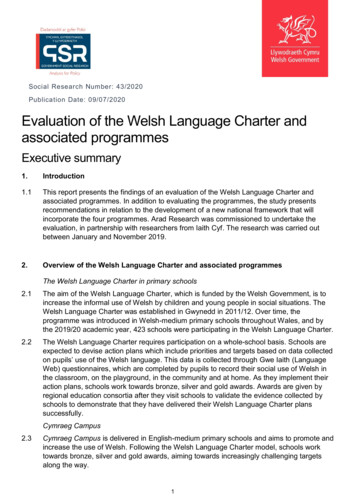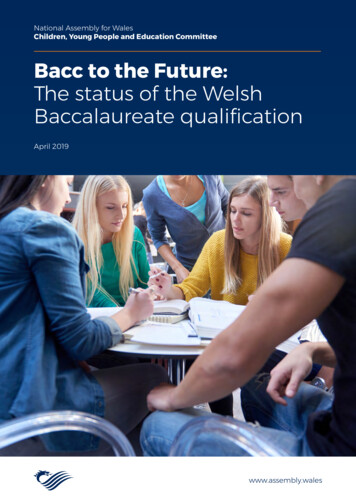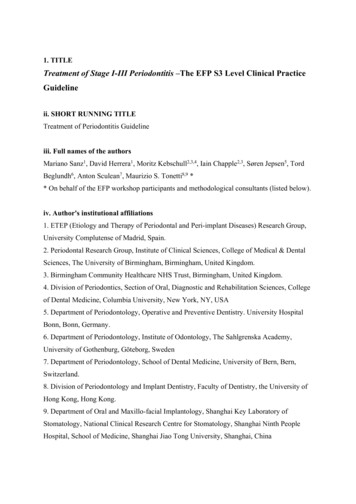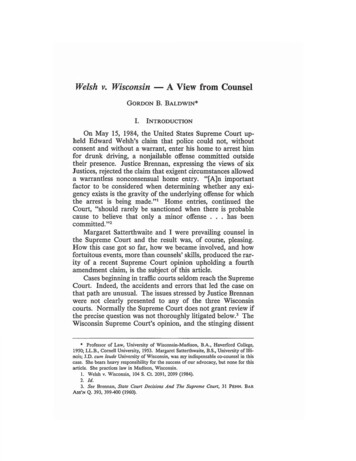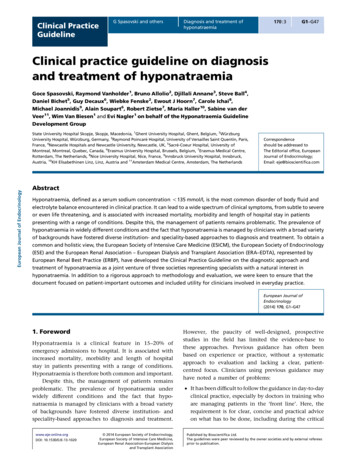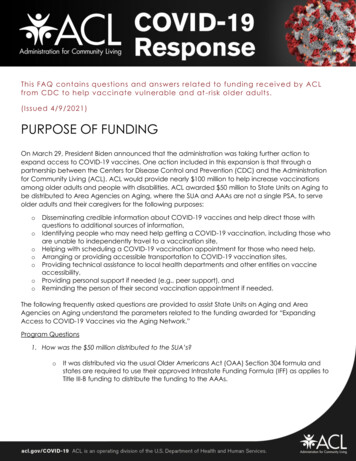
Transcription
Welsh European Funding OfficeEligibility Rules and Conditions for Support from theEuropean Structural Funds 2014-2020Version 4May 20191Version 1
VERSION 014Not published on EU Funding pages of the WelshGovernment website. Issued directly to ERDF applicants.1.1 &1.1b(ERDFand ESF)2 April20152.0August20163.0January2018Version 1.0 expanded to include ESF.Updated to reflect latest procurement legislation andrules.Version 1.1b is identical to Version 1.1 other than slightlyamended wording in Section 25 regarding when writtenconfirmations from third parties may be accepted.Clarification of topics e.g. agency workers, unit costs forproject staff costs, ineligible participants attending ESFfunded activities/ operations, procurement process to beadopted within schemes being delivered by IntermediateBodies and refresh of Annex D to replicate WEFOdocument entitled,’ Guidance on assessing participanteligibility’.Statement from CIFAS – sharing information with fraudprevention agencies. E-cohesion – paragraph removedtimeline for incorporation has lapsed. Vouchers & Tokens,amended when considered paid. Clarification on theapprenticeship levy – not a direct cost but can berecovered via the flat rate (indirect cost.) Paragraphadded to reinforce the need to keep records so that costclaimed/ calculations can be checked by audit/ MVT.Clarification on sick pay calculations added. Monthlyhourly rate calculation added. Line added to state thatBooking Fees are eligible if unavoidable. Clarification thatan asset register must be used for spend over 5k despiteown policies. Best practice note added regarding keepingan inventory log of all equipment purchased usingstructural funds. Note advising that the Work Programmeis closed to new entrants. Travel and subsistence costsfor ESF participants – clarification of evidencerequirements. Match Funding – clarification of what can/cannot be used as MF. Net Revenue – line added toclarify that revenue generated must be declared. In linewith Durability Rules a note has been added to informbeneficiaries of visits WEFO Management & VerificationsTeam will carry out post completion. Procurement sectionoverhauled for clarification also example of minimumrequirements. Clarification on State Aid: GBER & DeMinimis Schemes added. Line added regarding Schedule3 of WEFO funding agreements and the need for them to2
be signed by each joint beneficiary prior to the leadbeneficiary including their costs within claims to WEFO.Annex D removed and beneficiaries directed to theguidance entitled ‘European Social Fund 2014-2020:Guidance on Assessing Participant Eligibility.’ Template 3- Example of best practise secondment letter.4.0May 2019Update to reflect changes to Structural Fund Regulationsfollowing the adoption of the ‘Omnibus’ Regulation 2018GLOSSARYUs, our, weThe Welsh European Funding Office (WEFO), a part of theWelsh Government and the designated programme managingauthority and certifying authority.You, yourThe beneficiary of the EU funds as defined in the separateguidance ‘WEFO Delivery Models 2014-2020’.EC, theCommissionERDFEuropean CommissionESFEuropean Social FundEU, the UnionEuropean UnionProgrammesThe Wales Structural Funds Operational Programmes, being theformal programming documents adopted by the EC.Operations,projectsThe proposals set out in your funding application and approvedby us or by an Intermediate Body where designated by us. Theterms are explained further in the separate guidance ‘WEFODelivery Models 2014-2020’ available on the EU Funding pagesof the Welsh Government website.Regulations,EU Regulations,EU legislationStructuralFundsEU law with binding legal force throughout every EU MemberState, on a par with national laws. The Structural Fundslegislative package is listed below#ERDF and ESFEuropean Regional Development Fund3
#The Structural Funds EU legislation is subject to ongoing amendment and additionbut at the time of publication comprises: Regulation EU 1303/ 2013, 17 December 2013 (The ESI Fund CommonProvisions and Structural Funds General Provisions)Regulation EU 1301/ 2013, 17 December 2013 (The ERDF Regulation)Regulation EU 1304/ 2013, 17 December 2013 (The ESF Regulation)Regulation EU 288/ 2014, 25 February 2014 (Commission ImplementingRegulation)Regulation EU 184/ 2014, 25 February 2014 (Commission ImplementingRegulation)Regulation EU 480/ 2014, 3 March 2014 (Commission Delegated Regulation)Regulation EU 215/ 2014, 7 March 2014 (Commission Implementing Regulation)as amended by Regulation EU 1232/ 2014, 18 November 2014Regulation EU 522/ 2014, 11 March 2014 (Commission Delegated Regulation)Regulation EU 821/ 2014, 28 July 2014 (Commission Implementing Regulation)Regulation EU 1011/ 2014, 22 September 2014 (Commission ImplementingRegulation)Regulation EU 207/ 2015, 14 February 2015 (Commission ImplementingRegulation)Regulation EU 2015/ 1970, 8 July 2015 (Commission Delegated Regulation)Regulation EU 2018/ 276, 23 February 2018 (Commission ImplementingRegulation)Regulation EU 2018/ 277, 23 February 2018 (Commission ImplementingRegulation)Regulation EU 522/ 2014, 11 March 2014 (Commission Delegated Regulation)Regulation EU 240/ 2014, 7 January 2014 (Commission Delegated Regulation)Commission Implementing Decision 2014/ 190/ EUCommission Implementing Decision 2014/ 99/ EUCommission Decision of 19.12.2013Commission Recommendation of 6 May 2003Omnibus Regulation 2016/ 02824
ContentsPART 1: e and Dimensions of Eligibility9999PART 2: GENERAL RULES AND CONDITIONS5Basic Rules5.1Clarifications and Guidance5.1.1 Basis of Support5.1.2 Treatment of Errors and Fraud5.1.3 Substitution of Ineligible Costs5.1.4 Audit Trails5.1.4.1 Document Retention Periods5.1.4.2 Format of Documents5.1.4.3 Documents not held at the Beneficiary’s Premises111212121313131418PART 3: ELIGIBLE COSTS67Methods of Calculating and Declaring Eligible CostsReal Costs7.1Definition of Real Costs7.2Rules – Real Costs7.3Clarifications and Guidance7.3.1 Definition of ‘Incurred’7.3.2 Definition of ‘Paid’7.3.3 Definition of ‘Identifiable and Verifiable’7.3.4 Paying for Goods or Services in Advance7.3.5 Retentions, Contingency Sums, Escrow Accounts andPayment Schemes7.4Rules – Value for Money7.5Clarifications and Guidance7.5.1 Value for Money7.5.2 Recurring Purchases of Low-value Items7.5.3 Double-financing Rule7.5.4 Use of the Beneficiary’s Facilities, Assets and OtherEquipment7.6Rules – Eligibility Dates7.7Clarifications and Guidance7.7.1 Retrospective Approval of Operations7.7.2 Preliminary Costs (Works Contracts)8Cost Categories: Direct Costs8.1Definition of Direct Costs5202121212122222323242525252526262727272828
8.2Allocation of Direct Costs8.3Definition of Indirect Costs9Direct Staff Costs9.1Rules9.2Clarifications and Guidance9.2.1 Time Recording9.2.2 Staff Training9.2.3 Inward Secondments9.2.4 Exceptional Paid Leave9.2.5 Redundancy and Severance Schemes9.2.6 Discretionary Payments9.2.7 Recruitment, Relocation and Disruption Payments10Office and Administrative Costs10.1 Clarifications and Guidance10.1.1 Hospitality and Entertaining10.1.2 Statutory and Obligatory Costs10.1.3 Insurance10.1.4 Use of Beneficiary’s Premises and Equipment11Travel and Subsistence for Direct Staff12External Services and Experts12.1 Payments to Incentivise Engagement in WEFO ProgrammeEvaluations13Equipment13.1 Method of Acquisition: Purchase, Rent or Lease13.2 Depreciation Charges13.3 Second-hand Equipment14Capital Expenditure14.1 Site Preparation14.2 Asset Registers15Direct Costs of Providing Financial Support to Others16Cost Categories: Indirect Costs17Contributions In-Kind17.1 Rules, Clarifications and Guidance17.1.1 Unpaid Work (Volunteers’ Time)17.1.2 Donations of Land and Buildings17.1.3 Accounting for Contributions In-Kind18Summary and Further Clarification of Ineligible Costs19Simplified Costs19.1 Introduction19.2 Key Features19.3 Applicability of Simplified Costs19.4 Exclusion of ‘Fully Procured’ Activities, Projects or Operations19.5 Project Phases and Simplified Costs: WEFO Mobilisation Phase19.6 Simplified Costs Rates, Terms and Conditions19.6.1 Flat-rate 15% for Indirect Costs19.6.2 Flat-rate 25% for Indirect Costs (RD&I)19.6.3 Flat-rate 40% for Direct and Indirect Costs19.6.4 Flat-rate 20% for Direct Staff 47484848494950505252545555555757585961616161626464
19.6.5 Unit Costs for Project Staff Costs65PART 4: FUND-SPECIFIC RULES: ERDF202122Eligible ERDF ActivitiesGeographic Eligibility of ERDF OperationsMajor Projects676869PART 5: FUND-SPECIFIC RULES: ESF23242526272828.228.32930Eligible ESF Activities71Geographic Eligibility of ESF Activities7224.1 Activities Taking Place Outside of the EU73Geographic Eligibility of ESF Participants7325.1 Detailed Rules74ESF Participants Time (Contributions in-kind from Employers)78Care Costs to Enable Individuals to Participate in ESF Activities81Participant Eligibility8128.1 General Criteria81Project-Specific Criteria81Assessment of Eligibility and Audit Trail83Rules for Award of Bursaries, Scholarships, Allowances, Stipends and SimilarDirect Financial Support to Participants84Additional Value for Money Considerations86PART 6: OTHER FUNDING CONDITIONS31323334353636.236.336.43738Eligible Activities87Revenue88Match Funding93Publicity Rules and the Visibility of EU Funding95Durability Rules98Compliance with Applicable Laws and Regulations (EU, UK, Wales)9936.1 EU Laws and Regulations100UK and Wales Laws and Regulations100Procurement Rules10036.3.1 Compliance with Procurement Legislation10136.3.2 Contracts Outside the Scope of the Procurement Legislation10236.3.3 Organisations Falling within the Scope of the Wales PublicProcurement Statement10536.3.4 Minimum Standards for all Purchasing and Procurement10636.3.5 Organisations/ Small to Medium Sized Enterprises (Beneficiaries)Receiving Direct Financial Support via a Grant Scheme Subject to State AidRules10736.3.6 Handling (Actual or Perceived) Conflicts of Interest108State Aid Rules111Technical Assistance Rules and Conditions114Combining Support from More Than One EU Fund1157
ANNEX AANNEX BANNEX CANNEX DANNEX ETEMPLATE 1:TEMPLATE 2:TEMPLATE 3:WEFO Collaborative OperationsAudits and VerificationsAudit TrailsSimplified Cost OptionsProcured Delivery of Workplace Safety Training (ESF)Time Sheet to Record Direct Staff TimeEmployer’s Declaration of Participant’s TimeExample of secondment letter8117119121126132
PART 1: INTRODUCTION1. BackgroundThe rules and conditions governing the use of the European Structural Funds aredetermined partly by EU legislation and partly by national rules established by theWelsh European Funding Office (WEFO).Welsh national rules apply in the absence of a specific rule in the EU legislation orwhen the national rules are stricter than EU requirements. The Welsh nationaleligibility rules are just as important as the EU rules and to disregard them has thesame consequence of making the associated expenditure ineligible for EU support.2. PurposeThe purpose of this document is to help beneficiaries, and potential beneficiaries,understand and apply both the national and the European rules by avoiding,wherever possible, technical terms, legal references and jargon, and providinganswers to practical questions and examples of best practice.3. ApplicabilityThe rules and conditions in this document apply to the four European StructuralFunds programmes in Wales that contribute towards the ‘Investment for jobs andgrowth’ EU objective, namely: European Regional Development Fund Programme for East WalesEuropean Regional Development Fund Programme for West Wales and theValleysEuropean Social Fund Programme for East WalesEuropean Social Fund Programme for West Wales and the Valleys4. Scope and Dimensions of EligibilityThe rules and conditions relate exclusively to grants and repayable assistance.Repayable assistance (sometimes called ‘repayable grants’) is direct financialsupport that, in certain circumstances, must be repaid to us in part or in full.Separate rules and conditions will be published in due course for FinancialInstruments – repayable investments such as equity, loans and guarantees –supported by the Wales Structural Funds programmes.Finally, the Ireland-Wales European Territorial Cooperation programme, funded bythe ERDF, has its own programme eligibility rules and so is also excluded from thescope of this document.9
OVERVIEW: Dimensions of EligibilityEU support is paid in relation to the eligible expenditure of beneficiaries. Theeligibility of expenditure is a much broader concept than just the eligibility of costs.There are many dimensions of expenditure that make it eligible for a contributionfrom the Structural Funds:GeographiceligibilityScope ofinterventionCostsTiming ofexpenditureLevel orincidence ofexpenditureOther EU/UK/ Welshlaws andregulationsInformationand publicityrequirementsThe EU supported activities may need to take place in a specifiedgeographical area. Businesses or people receiving support from a projectmay also need to be located in a certain geographical area.There are restrictions on the types of activity and industries that can besupported by the Structural Funds.Some types of costs are always ineligible and others are only eligiblesubject to certain conditions. The ability to demonstrate a direct link of acost to an eligible project activity may also influence its eligibility status(whether an ‘indirect’ or a ‘direct’ cost).There are rules on the period in which expenditure and activity can takeplace, including special rules on expenditure that has taken place before agrant funding agreement is concluded.Eligible expenditure is only ‘counted’ at agreed points in the paymentschain, depending on who is making the payment and when the funds areactually paid out.All activities financed by the EU Funds must comply with EU rules andpolicies such as public procurement, competition, the environment andequal opportunities as well comply with UK/ Welsh laws and regulations.Support must comply with EU State Aid rules and where those rules arestricter than Structural Funds rules, they always take precedence.The support from EU Funds must be well publicised by beneficiaries.‘real costs’rulesWith the exception of depreciation charges and third party contributions inkind, only costs actually borne by a beneficiary, and supported by invoicesor equivalent documents, are eligible.‘simplifiedcosts’ rulesEligible costs must be calculated and declared in compliance with theapplicable terms and conditions set out in our grant funding agreement.Simplified costs cannot be used to declare the eligible costs of fullyprocured activities, projects or operations.Audit trailsDurability ofprojectsEvidence of expenditure, activities, outputs and of compliance with allapplicable funding conditions must be kept until the beneficiary has beeninformed by WEFO that they are no longer required.In some cases, investments/ activities/ assets must be maintained for acertain time beyond the end of the project implementation period to avoidneeding to repay the EU support.10
PART 2: GENERAL RULES ANDCONDITIONS5. Basic Rules[1] You must comply with the rules and conditions set out in this document.[2] Costs are only eligible if they are necessary for managing, initiating orimplementing the activities and actions approved by us.[3] Project activity and spending must be lawful, complying with all applicable Welsh,UK, EU and international laws and regulations.[4] A suitable cost budget line must be approved by us for the types of cost that youintend to declare as eligible (staff costs, capital expenditure, indirect costs etc.). Thiswill be evidenced in the financing plan and delivery profile or related documentsapproved by us.[5] You must comply with the general and specific conditions set out in our grantfunding agreement and any applicable EU State Aid rules, which may go beyondthe rules and conditions described in this document.[6] You must ensure that all relevant accounting records and supportingdocuments are retained, both financial and non-financial information, todemonstrate compliance with the rules and conditions. These must be retained untilwe notify you that they are no longer required.[7] You must maintain an up-to-date record of the name and address of allorganisations that you have agreed can retain project records, including jointbeneficiaries, contractors and other delivery partners.[8] The audit trail must be verifiable, readily accessible and held in a format thatprotects their authenticity and integrity.[9] Accounting records and supporting documents must be accessible for audits,verifications and any related investigation. Please see Annex B for more about‘audits and verifications’. We will aim to provide as much notice as possible but ECauditors are only legally obliged to provide 12 working days’ notice of audit visits,therefore you should ensure that your records management arrangements aresufficiently robust to cater for such requests.[10] You must facilitate access to project records if requested by us, the designatednational audit and control bodies or the relevant EU institutions (EuropeanCommission, European Court of Auditors, European Anti-fraud Office).11
5.1 CLARIFICATIONS AND GUIDANCE5.1.1 Basis of SupportThe EU support paid to you will be a non-repayable grant unless identified as‘repayable assistance’ in your grant funding agreement. ‘Non-repayable grant’means that the EU financial contribution does not need to be repaid to us as long asthe funding rules and conditions are satisfied.5.1.2 Unintentional Mistakes (‘Errors’) and FraudAlthough errors are relatively infrequent, and fraud even rarer, we must protect theEU budget by putting measures in place to prevent, detect and correct any errorsand to thoroughly investigate any suspicions of fraud.Expenditure that does not comply with the EU or national rules is irregular (an‘irregularity’) and cannot therefore be declared to the EC as expenditure thatqualifies for EU support. If the EU support has already been paid out by us to abeneficiary, the EC requires us to seek recovery of the amounts unduly paid.Fraud, in the context of the EU programmes, means intentionally doing something ordeclaring something that you know is false and results in, or could have resulted in,EU funds being paid out in error. It also means intentionally not doing something ornot declaring something that you know would (or could) result in EU funds being paidin error. Therefore, this definition applies to overstating eligible expenditure andunderstating - or not reporting - project revenue and receipts, as well as noncompliance with other reporting and notification obligations set out in our grantfunding agreement.We have a zero tolerance approach to fraud and any suspicions of fraud will beinvestigated. We also have a regulatory obligation to inform the European AntiFraud Office (OLAF) of both suspected and actual fraud cases.FRAUD PREVENTIONPlease note that we may share data you provide to us with fraud preventionagencies and third parties for the purposes of preventing and detecting fraud. Inorder for us to comply with the fair processing principle of data protection we need toadvise you how your personal data may be used.The information we collect from you will be shared with fraud prevention agencieswho will use it to prevent fraud and money-laundering and to verify your identity. Iffraud is detected, you could be refused certain services, finance or employment infuture. Further details of how your information will be used by us and these fraudprevention agencies, and your data protection rights, can be found by ctionofficer@gov.wales12
Further information is also available rnment-grantsIf you have any queries on this please get in touch with WEFO5.1.3 Substitution of Ineligible CostsIf our verifications or audits identify that some of your declared eligible costs are, infact, ineligible for EU support, you will not be allowed to replace that amount withnew replacement expenditure. In other words, the total eligible costs approved foryour project will, in effect, be reduced by the amount of the ineligible costs and theEU contribution that would have been paid for that part of the expenditure will belost. We will re-use this cancelled EU contribution for the benefit of other operationssupported by the EU programme.5.1.4 Audit TrailsThe audit trail comprises two elements: accounting records and supportingdocuments.‘Document’ means either an electronic medium (digital records, records thatoriginate in digital form or hard-copy documents converted into digital form) or paperrecords (a ‘hard-copy’) that contains relevant information or data [see article 2(17)EU 1303/ 2013].‘Accounting Records’ means the financial records for the eligible expenditure,match funding, project revenue and other receipts that are coded/ charged to theproject and underpin the amounts that you declare to us in your regular paymentclaims.You must ensure that an adequate audit trail is maintained to demonstrate theeffective and compliant implementation of your project and the eligibility ofexpenditure declared.You must ensure that all relevant records and documents are made available onrequest as set out in the grant funding agreement, for example to facilitateverifications, audits or any related investigations.Annex C provides further practical guidance.5.1.4.1 Document and Record Retention PeriodsUnlike previous programming periods, retention periods for beneficiaries are nolonger linked to the Programme closure process, meaning that average retentionperiods will reduce to between 5 and 10 years from the date that you declareexpenditure to us or, if applicable, to an Intermediate Body.13
In most cases, the retention period will be around 3 years following the end ofyour operation.However, if the total eligible expenditure approved for your operation does notexceed 1m, the retention period in most cases will be much shorter – around 4years from the submission of each payment claim to us or the IntermediateBody.You will be informed in writing of the actual retention periods that apply to youroperation.The detailed rules for determining the precise retention period are set out in the boxbelow.NOTE FOR WEFO STAFFWEFO must inform beneficiaries in writing of the start date for determining thedocument retention period and the retention period. The retention period will eitherbe:- for operations where the total approved eligible expenditure is less than EUR 1m,3 calendar years from the 31 December that follows the inclusion of the annualeligible expenditure in the accounts submitted by WEFO to the EC each March.- for all other operations, 2 calendar years from the 31 December that follows theinclusion of the final eligible expenditure that signifies the completion of theoperation.The pounds sterling value of the 1m threshold is only considered at operationapproval stage.The beneficiary may still need to retain documents for a longer period if required bythe applicable State Aid rules or if audits or investigations are underway and thebeneficiary is specifically advised to retain the audit trails until further notice.See EU 1303/ 2013, article 140, para 1 and 2.The task of informing aid scheme beneficiaries of the start date can be performed byWEFO or delegated to the Intermediate Body (if an IB is managing the aid schemeoperation).5.1.4.2 Format of DocumentsDocuments can be retained in any of the following formats: Documents that originate and exist only in their native digital form i.e. so-called‘born digital’ records such as e-mails, database records, spreadsheets and wordprocessing files etc. This extends to both structured and unstructured records14
and includes, for example, electronic records management systems; digital fileformats, such as PDF, JPEG and TIF when created and then transmitted digitally;databases; video clips, digital photography etc. Electronic/ digital versions of original paper documents held on commonlyaccepted data carriers such as microfilm, digitised/ scanned/ replica images etc. Original paper documents. Certified true copies of an original paper document.[See article 140 of EU 1303/ 2013].Conditions for accepting documents that originate in electronic/ digital formTo ensure that the authenticity and integrity of ‘electronic/ digital only’ records so thatthey can be relied upon for legal and audit purposes, you must be satisfied that theICT/ information management systems in place are designed to conform to acceptedsecurity standards in the UK. Specifically, the system must be designed to conformto British Standard BSI BIP0008-1:2014 or ISO 27001:2013.Where an alternative security standard is utilised by a beneficiary advancenotification of the system must be provided to WEFO together with, where available,evidence to substantiate the system is comparable to British Standards/ ISOrequirements. WEFO will then confirm whether the alternative is an acceptedsecurity standard in the UK.You should obtain the relevant assurances on security standards from your ICT/Information Assurance Officer or management team. This approach extends toseeking assurance on records held on the ICT systems of any joint beneficiaries orcontracted/ third party deliverers holding documents electronically/ digitally.For the purposes of our verifications and audits, you should keep a document thatdescribes the procedures you have undertaken to obtain the necessary assurancesthat adequate security standards are in place to rely on the information heldelectronically/ digitally.If you are unable to obtain the necessary assurances on the security standards, thenthe records will not be acceptable for EC/ WEFO compliance purposes [article140(6) of EU 1303/ 2013].Conditions for accepting digitised, scanned, replica digital versions of original paperdocumentsBeneficiaries using scanning, e-archiving or image processing systems (whereoriginal paper documents are scanned and stored in digital form) must ensure thatcertification processes and controls are in place that, at least:15
Guarantee that each ‘e-document’ (scanned image) is identical to the paperoriginal.Prevent or detect the scanning of the same paper document to produce severaldifferent e-documents of the same original document (each e-document remainsunique and cannot be re-used for any other than its initial purpose).Where the document evidences a financial transaction, the approval, accountingand payment process for each e-document should be unique (it should not bepossible to approve, account for, or pay the same e-document twice).Once scanned, processes and controls prevent or detect the amendment of edocuments or the creation of altered copies (or amended/ altered versions areheld as separate versions and the original, unaltered version of the imageremains available for audit purposes).Verifications and audits may ask to examine the policies and procedures in place toprovide assurance of the above certification processes and controls, and may alsoask to observe the scanning and certification process taking place in real time.Certified true copies of original paper documents (photocopies)The photocopied document must contain a ‘certification statement’. The certificationdeclaration must be annotated on, or appended to, the copy. The original documentdoes not need to be marked.If a document contains multiple pages then the first page should be certified and thenumber of attached pages indicated on the front page (alternatively, each page couldbe certified).The certification statement must be authorised/ signed and dated by an employeewho can vouch that the copy is a true replica image of the original.The certification statement is added at the time that the copy is made. Alternatively,the certification statement can be added shortly afterwards if the signatory can recallseeing the original and is therefore still able to confirm that the copy is satisfactory.The ‘certification statement’ can be chosen by each beneficiary but must, at least,contain the following: Signature [or similar evidence of authorisation]Date‘True copy’, ‘certified copy’, ‘certified’ [or similar phrase to signify what thesignature and date represents]It is recommended, but not mandatory, that the certification statement also includesthe printed name/ position of the signatory or other unique reference (such asemployee/ payroll number) so that future project staff and/ or auditors are able toeasily identify the signatory if required.16
The following is an example of a compliant certification statement:I certify this document as a true copy of the originalSIGNATURE:DATE:PRINTED NAME/ POSITION IN ORGANISATION [optional]:NAME OF ORGANISATION [optional]:NUMBER OF PAGES CERTIFIED IN THIS DOCUMENT [if applicable]:If more efficient, a single certification declaration can be used for a batch ofphotocopies. The certification statement must include: a unique batch reference number/ code to identify the batch.the number of documents – and pages if individual documents contain more thanone page – included in the certified batch.the references/ numbers of each of the documents included in the batch. If thedocuments are not already referenced/ numbered, then references/ numbersshould be added to each document prior to batch certification.Other considerationsWhen deciding on the most appropriate document format, please remember thatrecords may need to be retained for a longer period than your normal organisationrecords retention policy requires. You may need to label and store EU projectrecords to prevent their premature destruction. You will also need to considerpractical issues such a
Eligibility Rules and Conditions for Support from the European Structural Funds 2014-2020 Version 4 May 2019 . 2 VERSION HISTORY Version Date Comments 1.0 (ERDF . requirements. Match Funding - clarification of what can/ cannot be used as MF. Net Revenue - line added to clarify that revenue generated must be declared. In line
